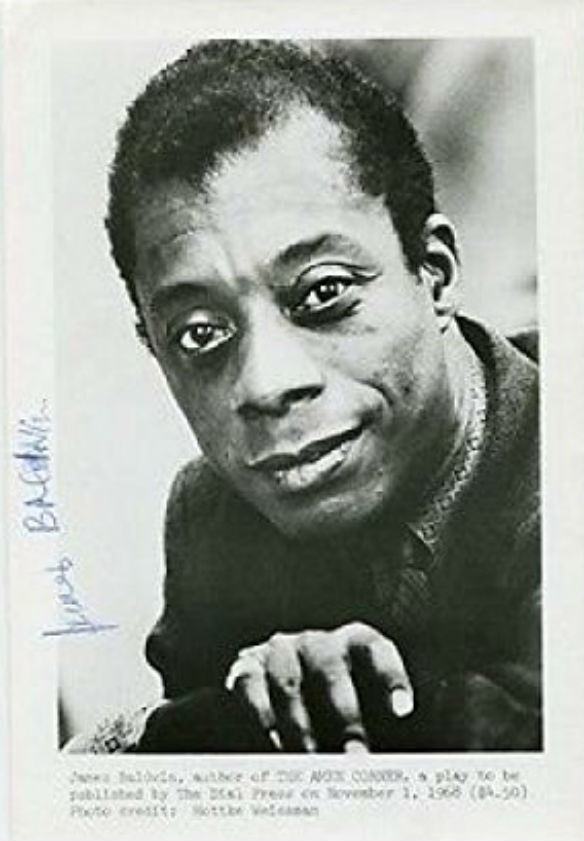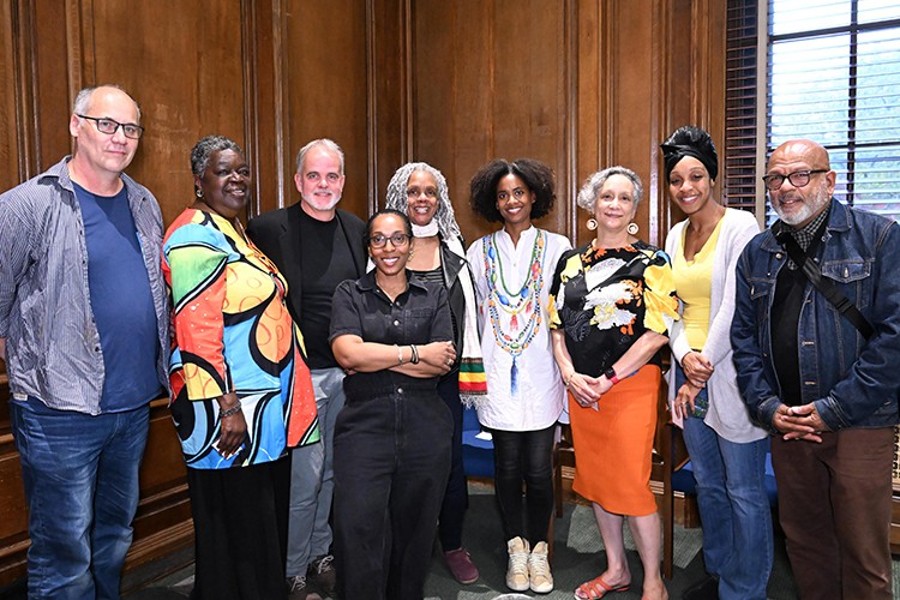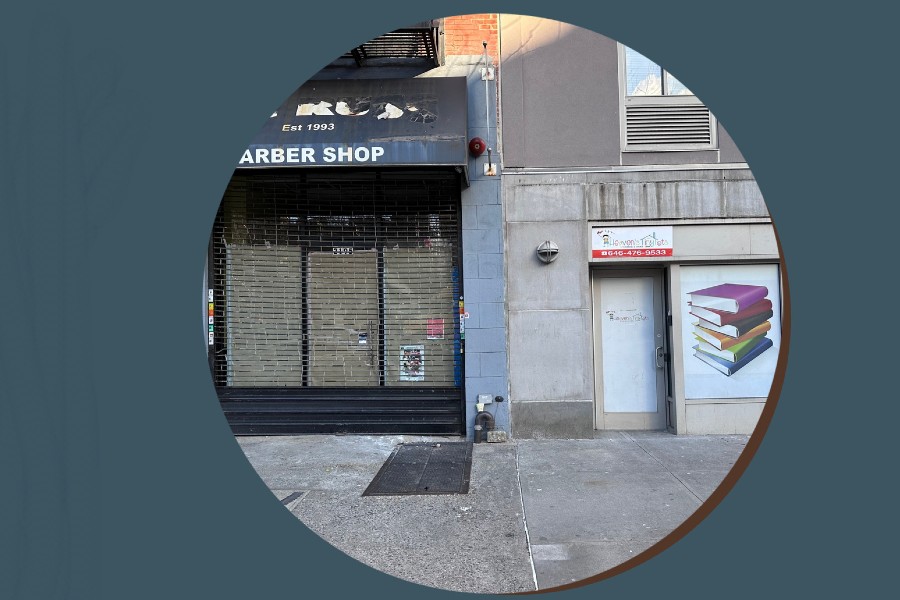 James Arthur Baldwin (August 2, 1924 – December 1, 1987) was an American novelist, essayist, playwright, poet, and social critic. Baldwin’s essays, as collected in Notes of a Native Son (1955), explore palpable yet unspoken intricacies of racial, sexual, and class distinctions in Western societies, most notably in mid-20th-century America, and their inevitable if unnameable tensions.Some Baldwin essays are book-length, for instance The Fire Next Time (1963), No Name in the Street (1972), and The Devil Finds Work (1976).
James Arthur Baldwin (August 2, 1924 – December 1, 1987) was an American novelist, essayist, playwright, poet, and social critic. Baldwin’s essays, as collected in Notes of a Native Son (1955), explore palpable yet unspoken intricacies of racial, sexual, and class distinctions in Western societies, most notably in mid-20th-century America, and their inevitable if unnameable tensions.Some Baldwin essays are book-length, for instance The Fire Next Time (1963), No Name in the Street (1972), and The Devil Finds Work (1976).
Baldwin’s novels and plays fictionalize fundamental personal questions and dilemmas amid complex social and psychological pressures thwarting the equitable integration of not only blacks, but also of gay and bisexual men, while depicting some internalized obstacles to such individuals’ quests for acceptance. Such dynamics are prominent in Baldwin’s second novel, written well before gay equality was widely espoused in America: Giovanni’s Room (1956).Baldwin’s first novel, Go Tell It on the Mountain, is said to be his best-known work.
When Baldwin was an infant, his mother, Emma Berdis Jones, divorced his father amid his drug abuse and moved to the Harlem section of Manhattan in New York City. There, she married a preacher, David Baldwin. The family was very poor.
James spent much time caring for his several younger brothers and sisters. At age ten, he was beaten by a gang of police officers. His adoptive father, whom James in essays called simply his father, appears to have treated James—versus James’s siblings—with singular harshness.
His stepfather died of tuberculosis in summer of 1943 soon before James turned 19. The day of the funeral was James’s 19th birthday, the day his father’s last child was born, and the day of the Harlem Riot of 1943, which was the portrait opening his essay “Notes of a Native Son”. The quest to answer or explain familial and social repudiation—and attain a sense of self, both coherent and benevolent—became a motif in Baldwin’s writing.
James attended DeWitt Clinton High School, in the Bronx’s Bedford Park section. There, along with Richard Avedon, he worked on the school magazine—Baldwin as its literary editor—but disliked school. After high school, Baldwin studied at The New School, where he found an intellectual community that he could identify with.
The difficulties of his life, as well as his abusive preacher stepfather, led Baldwin to become a part of the church. At age 14 he attended meetings of the Pentecostal Church and, during a euphoric prayer meeting, he converted. Soon, as a junior minister at the Fireside Pentecostal Assembly, he drew larger crowds than his stepfather did. At 17, however, Baldwin came to view Christianity as falsely premised and later regarded his time in the pulpit as a remedy to his personal crises.
Baldwin once visited Elijah Muhammad, founder of the Nation of Islam, who inquired about Baldwin’s religious beliefs. He answered, “I left the church 20 years ago and haven’t joined anything since.” Elijah asked, “And what are you now?” Baldwin explained, “I? Now? Nothing. I’m a writer. I like doing things alone.” Still, his church experience significantly shaped his worldview and writing. Baldwin reflected that “being in the pulpit was like being in the theatre; I was behind the scenes and knew how the illusion was worked.”
Baldwin admonished Christianity for, as he explained, reinforcing the system of American slavery by palliating the pangs of oppression and delaying salvation until a promised afterlife. Baldwin praised religion, however, for inspiring some American blacks to defy oppression. Baldwin once wrote, “If the concept of God has any use, it is to make us larger, freer, and more loving. If God can’t do that, it’s time we got rid of him”. Yet Baldwin never publicly identified himself as atheist. At his funeral, a mostly a cappella recording of the adult Baldwin singing “Take My Hand, Precious Lord” was played.
When Baldwin was 15, his high-school running buddy, Emile Capouya, skipped school one day and, in Greenwich Village, met Beauford Delaney, a painter. Emile gave James the address, and suggested a visit. James, who worked at a sweatshop nearby on Canal Street and dreaded going home after school, visited Beauford at 181 Greene Street. He became a mentor to Baldwin, and Beauford’s influence brought him to his first realization that a black person could be an artist.
While working odd jobs, he wrote short stories, essays, and book reviews, some of them collected in the volume Notes of a Native Son (1955). He befriended the actor Marlon Brando in 1944 and the two were roommates for a time. They would remain friends for over 20 years.
During his teenage years in Harlem and Greenwich Village, Baldwin started to realize that he was bisexual. In 1948, Baldwin walked into a restaurant where he knew he could not be served. When the waitress explained that black people were not served the establishment, James Baldwin threw a glass of water at her, shattering the mirror behind the bar. As a result of being disillusioned by American prejudice against blacks and gays, Baldwin left the United States at age 24 and settled in Paris, France. His flight was not just a desire to distance himself from American prejudice, but to see himself and his writing beyond an African American context. Baldwin did not want to be read as not “merely a Negro; or, even, merely a Negro writer”. Also, he left the United States desiring to come to terms with his sexual ambivalence and flee the hopelessness that many young African American men like himself succumbed to in New York.
In Paris, Baldwin was soon involved in the cultural radicalism of the Left Bank. His work started to be published in literary anthologies, notably Zero, which was edited by his friend Themistocles Hoetisand which had already published essays by Richard Wright.
He would live in France for most of his later life. He would also spend some time in Switzerland and Turkey. During his life and after it, Baldwin would be seen not only as an influential African American writer but also as an influential exile writer, particularly because of his numerous experiences outside of the United States and the impact of these experiences on Baldwin’s life and his writing.
James Baldwin settled in Saint-Paul de Vence (South of France) in 1970, in an old Provence house beneath the ramparts of the famous village. His house was always open to his friends and they would never fail to pop in and say hello when visiting the French Riviera. American painter Beauford Delaney made James Baldwin’s house in Saint-Paul de Vence his second home, often setting up his easel in the garden. Beauford Delaney painted several colourful portraits of James Baldwin. Actors Harry Belafonte and Sidney Poitiers were also regular house guests.
A lot of Baldwin’s musician friends dropped in during the Nice and Juan-les-Pins jazz festivals: Nina Simone, Josephine Baker (whose sister lived in Nice), Miles Davis and Ray Charles for whom James Baldwin composed several pieces of music. In his biography, musician Miles Davis wrote:
I’d read his books and I liked and respected what he had to say. When I got to know him better, Jimmy and I opened up to each other. We became great friends. Every time I was in the South of France, in Antibes, I would spend a day or two at his villa in Saint-Paul de Vence. We’d get comfy in that beautiful, big house and he would tell us all sorts of stories… He was a great man.
James Baldwin spoke impeccable French and developed friendships with French actor Yves Montand and French writer Marguerite Yourcenar, who translated his play The Amen Corner.
His years in Saint-Paul de Vence were also years of work. Sitting in front of his sturdy typewriter, his days were devoted to writing and to answering the huge amount of mail he received from all over the world. He wrote several of his last works in his house in Saint Paul de Vence, including Just above my head in 1979 and Evidence of Things Not Seen in 1985. It was also in his Saint-Paul de Vence house that James Baldwin wrote his famous Open Letter to My Sister, Angela Y. Davis in November 1970.
In 1953, Baldwin’s first novel, Go Tell It on the Mountain, a semi-autobiographical bildungsroman, was published. Baldwin’s first collection of essays, Notes of a Native Son appeared two years later. Baldwin continued to experiment with literary forms throughout his career, publishing poetry and plays as well as the fiction and essays for which he was known.
Baldwin’s second novel, Giovanni’s Room, stirred controversy when it was first published in 1956 due to its explicit homoerotic content.Baldwin was again resisting labels with the publication of this work:despite the reading public’s expectations that he would publish works dealing with the African American experience, Giovanni’s Room is predominantly about white characters. Baldwin’s next two novels, Another Country and Tell Me How Long the Train’s Been Gone, are sprawling, experimental works dealing with black and white characters and with heterosexual, gay, and bisexual characters. These novels struggle to contain the turbulence of the 1960s: they are saturated with a sense of violent unrest and outrage.
Baldwin’s lengthy essay Down at the Cross (frequently called The Fire Next Time after the title of the book in which it was published) similarly showed the seething discontent of the 1960s in novel form. The essay was originally published in two oversized issues of The New Yorker and landed Baldwin on the cover of Time magazine in 1963 while Baldwin was touring the South speaking about the restive Civil Rights movement. Around the time of The Fire Next Time’s publication, Baldwin became a known spokesperson for civil rights and a celebrity noted for championing the cause of black Americans. He frequently appeared on television and delivered speeches on college campuses. The essay talked about the uneasy relationship between Christianity and the burgeoning Black Muslim movement. After publication, several black nationalists criticized Baldwin for his conciliatory attitude. They questioned whether his message of love and understanding would do much to change race relations in America. The book was eagerly consumed by whites looking for answers to the question: What do blacks really want? His essays never stopped articulating the anger and frustration felt by real-life black Americans with more clarity and style than any other writer of his generation. Baldwin’s next book-length essay, No Name in the Street, also discussed his own experience in the context of the later 1960s, specifically the assassinations of three of his personal friends: Medgar Evers, Malcolm X, and Martin Luther King, Jr.
Baldwin’s writings of the 1970s and 1980s have been largely overlooked by critics, though even these texts are beginning to receive attention. Several of his essays and interviews of the 1980s discuss homosexuality and homophobia with fervor and forthrightness. Eldridge Cleaver‘s harsh criticism of Baldwin in Soul on Ice and elsewhere and Baldwin’s return to southern France contributed to the sense that he was not in touch with his readership. Always true to his own convictions rather than to the tastes of others, Baldwin continued to write what he wanted to write. As he had been the leading literary voice of the civil rights movement, he became an inspirational figure for the emerging gay rights movement. His two novels written in the 1970s, If Beale Street Could Talk and Just Above My Head, placed a strong emphasis on the importance of black families, and he concluded his career by publishing a volume of poetry, Jimmy’s Blues as well as another book-length essay, The Evidence of Things Not Seen, which was an extended meditation inspired by the Atlanta Child Murders of the early 1980s.
Baldwin returned to the United States in the summer of 1957 while the Civil Rights Act of that year was being debated in Congress. He had been powerfully moved by the image of a young girl braving a mob in an attempt to desegregate schools in Charlotte, N.C., and Partisan Review editor Philip Rahv had suggested he report on what was happening in the American south. Baldwin was nervous about the trip but he made it, interviewing people in Charlotte, Atlanta (where he met Martin Luther King), and Montgomery, Alabama. The result was two essays, one published in Harper’s magazine (“The Hard Kind of Courage”), the other in Partisan Review (“Nobody Knows My Name”). Subsequent Baldwin articles on the movement appeared in Mademoiselle, Harper’s, the New York Times Magazine, and the New Yorker, where in 1962 he published the essay he called “Down at the Cross” and the New Yorker called “Letter from a Region of My Mind”. Along with a shorter essay fromThe Progressive, the essay became The Fire Next Time.
While he wrote about the movement, Baldwin aligned himself with the ideals of the Congress of Racial Equality (CORE) and the Student Nonviolent Coordinating Committee (SNCC). In 1963 he conducted a lecture tour of the South for CORE, traveling to locations like Durham and Greensboro, North Carolina and New Orleans, Louisiana. During the tour, he lectured to students, white liberals, and anyone else listening about his racial ideology, an ideological position between the “muscular approach” of Malcolm X and the nonviolent program of Martin Luther King Jr..
By the Spring of 1963, Baldwin had become so much a spokesman for the Civil Rights Movement that for its May 17 issue on the turmoil in Birmingham, Alabama, Time magazine put James Baldwin on the cover. “There is not another writer,” said Time, “who expresses with such poignancy and abrasiveness the dark realities of the racial ferment in North and South.” In a cable Baldwin sent to Attorney General Robert Kennedy during the crisis, Baldwin blamed the violence in Birmingham on the FBI, J.Edgar Hoover, Mississippi Senator James O. Eastland, and President Kennedy for failing to use “the great prestige of his office as the moral forum which it can be.” Attorney General Kennedy invited Baldwin to meet with him over breakfast, and that meeting was followed up with a second, when Kennedy met with Baldwin and others Baldwin had invited to Kennedy’s Manhattan apartment. The delegation included Kenneth B. Clark, a psychologist who had played a key role in the Brown v. Board of Education decision; actor Harry Belafonte, singer Lena Horne, writer Lorraine Hansberry, and activists from civil rights organizations. Although most of the attendees of this meeting left feeling “devastated,” the meeting was an important one in voicing the concerns of the civil rights movement and it provided exposure of the civil rights issue not just as a political issue but also as a moral issue.[38]
Baldwin also made a prominent appearance at the Civil Rights March on Washington, D.C. on August 28, 1963, with Belafonte and long time friends Sidney Poitier and Marlon Brando.[39] The civil rights movement was hostile to homosexuals. The only known gay men in the movement were James Baldwin and Bayard Rustin. Rustin and King were very close, as Rustin received credit for the success of the March on Washington. Many were bothered by Rustins sexual orientation. King himself spoke on the topic of sexual orientation in a school editorial column during his college years. The pressure later resulted in King distancing himself from both men. At the time, Baldwin was neither in the closet or open to the public about his sexual orientation. Later on, Baldwin was conspicuously uninvited to speak at the end of the March on Washington.[40] After a bomb exploded in a Birmingham church not long after the March on Washington, Baldwin called for a nationwide campaign of civil disobedience in response to this “terrifying crisis.” He traveled to Selma, Alabama, where SNCC had organized a voter registration drive; he watched mothers with babies and elderly men and women standing in long lines for hours, as armed deputies and state troopers stood by—or intervened to smash a reporter’s camera or use cattle prods on SNCC workers. After his day of watching, he spoke in a crowded church, blaming Washington—”the good white people on the hill.” Returning to Washington, he told a New York Post reporter the federal government could protect Negroes—it could send federal troops into the South. He blamed the Kennedys for not acting. In March 1964, Baldwin joined marchers who walked 50 miles from Selma, Alabama, to the capitol in Montgomery under the protection of federal troops.
Nonetheless, he rejected the label civil rights activist, or that he had participated in a civil rights movement, instead agreeing with Malcolm X‘s assertion that if one is a citizen, one should not have to fight for one’s civil rights. In a 1979 speech at UC Berkeley, he called it, instead, “the latest slave rebellion.”
In 1968, Baldwin signed the “Writers and Editors War Tax Protest” pledge, vowing to refuse tax payments in protest against the Vietnam War.
As a young man, Baldwin’s poetry teacher was Countee Cullen.
A great influence on Baldwin was the painter Beauford Delaney. In The Price of the Ticket (1985), Baldwin describes Delaney as
the first living proof, for me, that a black man could be an artist. In a warmer time, a less blasphemous place, he would have been recognized as my teacher and I as his pupil. He became, for me, an example of courage and integrity, humility and passion. An absolute integrity: I saw him shaken many times and I lived to see him broken but I never saw him bow.
Later support came from Richard Wright, whom Baldwin called “the greatest black writer in the world.” Wright and Baldwin became friends, and Wright helped Baldwin secure the Eugene F. Saxon Memorial Award. Baldwin’s essay “Notes of a Native Son” and his essay collection Notes of a Native Son allude to Wright’s novel Native Son. In Baldwin’s 1949 essay “Everybody’s Protest Novel”, however, Baldwin indicated that Native Son, like Harriet Beecher Stowe‘s Uncle Tom’s Cabin, lacked credible characters and psychological complexity, and the two authors’ friendship ended. Interviewed by Julius Lester, however, Baldwin explained, “I knew Richard and I loved him. I was not attacking him; I was trying to clarify something for myself.” In 1965, Baldwin participated in a debate with William F. Buckley, on the topic of whether the American dreamhas adversely affected African Americans. The debate took place at Cambridge University in the UK. The spectating student body voted overwhelmingly in Baldwin’s favour.
In 1949 Baldwin met and fell in love with Lucien Happersberger, age 17, though Happersberger’s marriage three years later left Baldwin distraught. Happersberger died on August 21, 2010 in Switzerland.
Baldwin was a close friend of the singer, pianist, and civil rights activist Nina Simone. With Langston Hughes and Lorraine Hansberry, Baldwin helped awaken Simone to the civil rights movement then gelling. Baldwin also provided her with literary references influential on her later work. Famously, Baldwin and Hansberry met with Robert F. Kennedy, along with Kenneth Clark and Lena Horne, in an attempt to persuade Kennedy of the importance of civil rights legislation.
Baldwin influenced the work of French painter Philippe Derome, who he met in Paris in the early 1960s. Baldwin also knew Marlon Brando, Charlton Heston, Billy Dee Williams, Huey P. Newton,Nikki Giovanni, Jean-Paul Sartre, Jean Genet (with whom he campaigned on behalf of the Black Panther Party), Lee Strasberg, Elia Kazan, Rip Torn, Alex Haley, Miles Davis, Amiri Baraka, Martin Luther King, Jr., Margaret Mead, Josephine Baker, Allen Ginsberg, Chinua Achebe and Maya Angelou. He wrote at length about his “political relationship” with Malcolm X. He collaborated with childhood friend Richard Avedon on the book Nothing Personal, which is available for public viewing at the Schomburg Center in Harlem.
Maya Angelou called Baldwin her “friend and brother”, and credited him for “setting the stage” for her 1969 autobiography I Know Why the Caged Bird Sings. Baldwin was made a Commandeur de la Légion d’honneur by the French government in 1986.
James Baldwin was also a close friend of Nobel Prize winning novelist Toni Morrison. Upon Baldwin’s death, Toni Morrison wrote a eulogy for Baldwin that appeared in the New York Times. In the eulogy, entitled “Life in His Language,” Toni Morrison credits James Baldwin as being her literary inspiration and the person who showed her the true potential of writing. She writes,
You knew, didn’t you, how I needed your language and the mind that formed it? How I relied on your fierce courage to tame wildernesses for me? How strengthened I was by the certainty that came from knowing you would never hurt me? You knew, didn’t you, how I loved your love? You knew. This then is no calamity. No. This is jubilee. ‘Our crown,’ you said, ‘has already been bought and paid for. All we have to do,’ you said, ‘is wear it.’
Early on December 1, 1987 (some sources say late on November 30) Baldwin died fromesophageal cancer in Saint-Paul-de-Vence, France. He was buried at the Ferncliff Cemetery in Hartsdale, near New York City.
Become a Harlem Insider!
By submitting this form, you are consenting to receive marketing emails from: Harlem World Magazine, 2521 1/2 west 42nd street, Los Angeles, CA, 90008, https://www.harlemworldmagazine.com. You can revoke your consent to receive emails at any time by using the SafeUnsubscribe® link, found at the bottom of every email. Emails are serviced by Constant Contact








